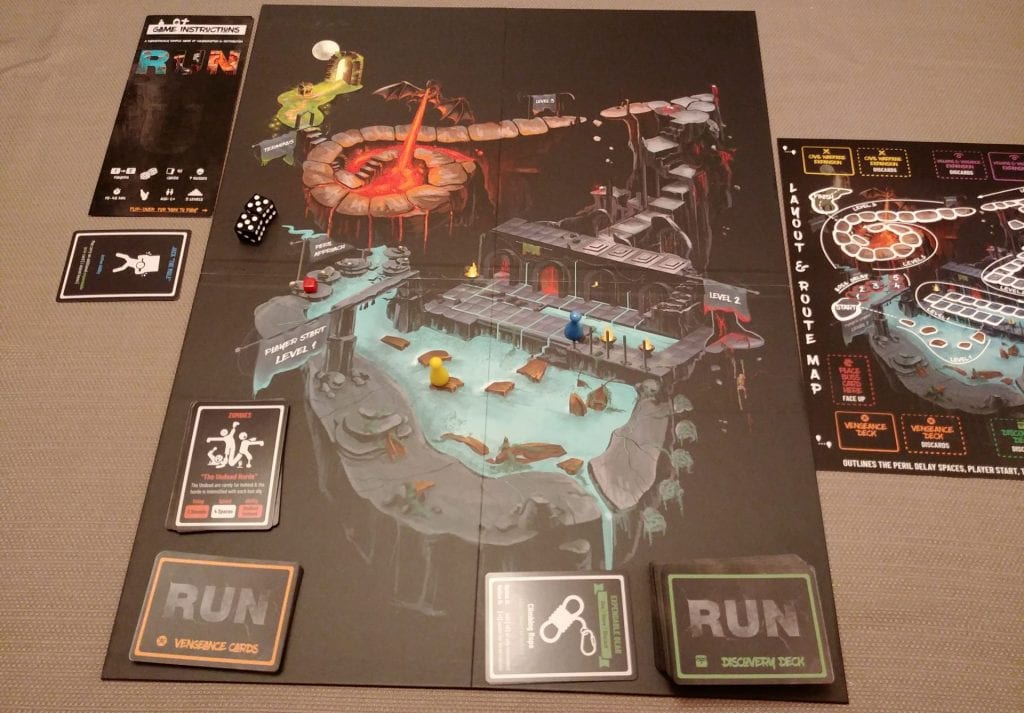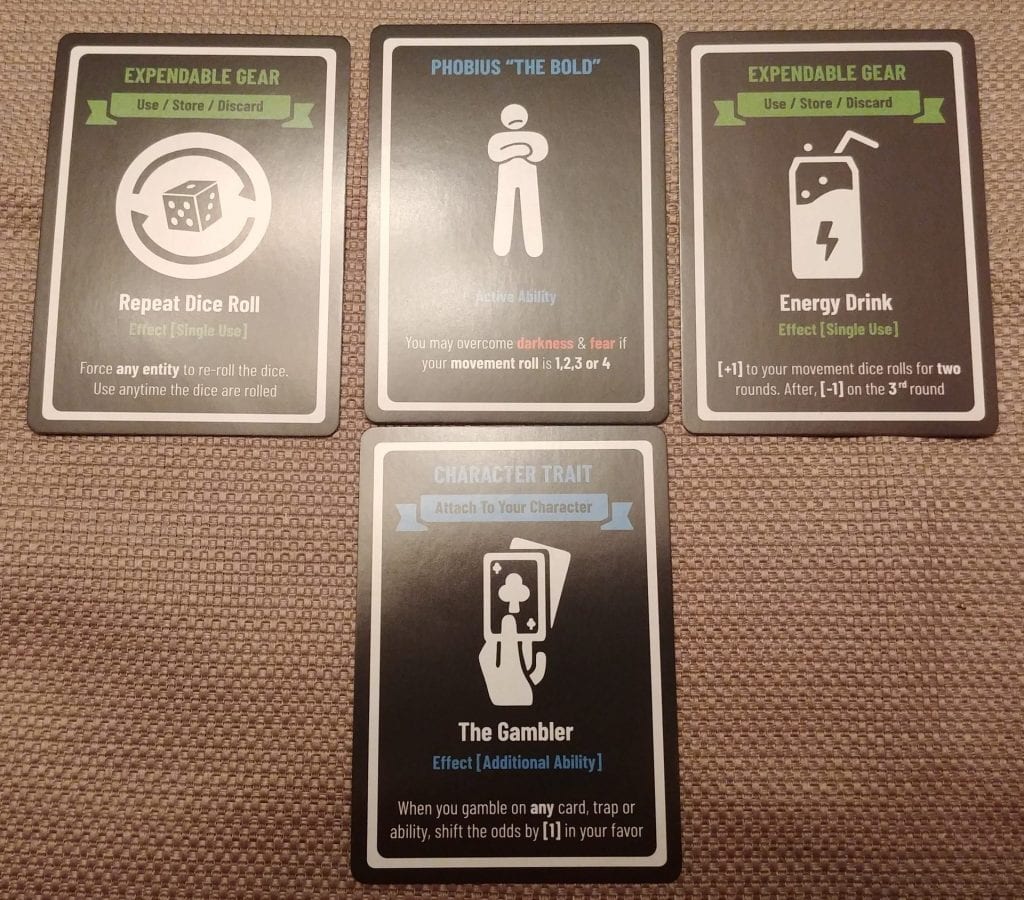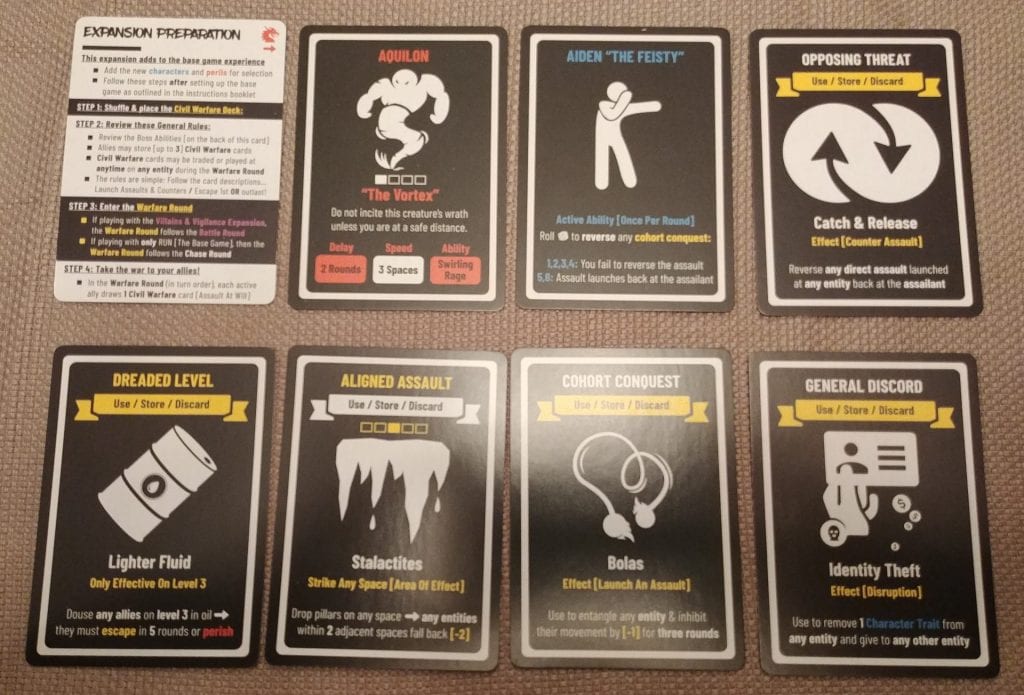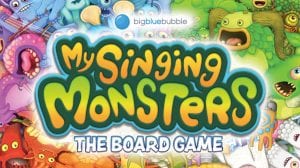RUN! is an experiment in co-operative/competitive simplicity that fizzles out. To be clear; this game can be fun BUT the instructions are so unclear that RUN! became less and less fun the deeper we got into it. There are a lot of things that need to be addressed with this game because, like all creations people put their soul into, RUN! deserves respect for creating a very cool looking game and running a successful Kickstarter campaign. The Happy Narwhal Co. ran a successful Kickstarter in 2020 and were able to produce a game that looks like a minimalist good time. However, as a board gamer that tries to find ‘gateway’ games for their family to play together, RUN! misses the mark. Why? Well, it may be the Kickstarter problem of trying to do too many things at once. Individually the pieces are great on paper, but the execution was not up to par for myself or my partner. Unfortunately, I did not get to experience this game as it was probably intended. I desperately wanted to play with the family this was intended for; but the pandemic in Canada means I’ve been unable to see anyone outside of my household and work the entire time I have had this game for review.
So, in the future, I would like to do an updated play and small piece on RUN!. I have read on the Kickstarter page some happy families that are enjoying RUN! and others that have been disappointed in what they have received. Please join me on this marathon of a review as I examine why you may want to run towards RUN!, or flee from it, but it will definitely be one or the other.

How to RUN!
The goal of the game is for players to escape the dungeon (cooperatively or competitively). Players must RUN! for their lives as they try to escape the imminent peril, a randomly drawn monster. Players draw a character, some with more useful traits than others, and begin their escape. On a turn each player will draw a Discovery Deck card, choose to use, discard, or store it, and then roll one six-sided die to see how far along the path to freedom they move. They can use Discovery Deck cards to modify their dice rolls, the rolls of their fellow escapees or the rolls of the peril.
Players can acquire character traits in the discovery deck and have as many as they like: which may help or hurt your escape. They can carry two discovery cards at once but can use those cards to help their allies or themselves if they exceed their limit. What is great about RUN! is that if a player dies, they are not out of the game, they come back as a vengeful ghost and use Vengeance cards against the other players. If you cannot escape, why should they?

The Almost too Minimalistic Game Board
When I first opened up the box for RUN! I was stunned by the cool looking multi-level board; the black background and art style spoke to me, it seemed more like a poster than a game board. Then I began setting up the game and realized that, if it were not for the included insert, I would have absolutely no idea where any of the decks were to go and I would not know where the different levels stopped and started. I would not know if some of the details on the board were spaces or if they were for show.
To me, this is a problem. Even as an ‘experienced’ board gamer I would pause to make sure that I was going to advance on the correct space between levels one and two. If I was confused, then I could only imagine the frustration new players may face when the board is unclear. Honestly, it would not have hurt the game at all to label the board with everything that was included on the insert. Yes, minimalism is cool, but in board games clarity is instrumental to fun.

The Game Pieces – Too Many and Not Enough
Included in the RUN! box I received are nine player tokens in different colours and fifteen small cube tokens, nine for the player colours and three additional black and purple tokens. The game rules never explicitly state that the extra purple and black tokens are for the Villains and Vigilance expansion; I guessed since the expansion box was black and purple.
The game rules state that players should use the red square token to represent the peril, aka what players are running from, on the board. However, the box only provides one red token so, if there are eight players playing (the technical maximum) then there is no item tracking token for the red player. Why even include the red pawn? For clarity’s sake, there should have been a specifically made peril token. This way there is no confusion over colour or where the peril is on the board.

The ability tracker on the side of the board is also, practically, inconvenient. There could have been small cardboard tokens provided that players could place on their cards to show many times the items have been used. Yes, this is more materials, and something that would drive up production costs, but it makes micromanaging abilities so much nicer. Players will not forget what they have done because the information is right in front of them, not one colourful cube amongst many on the board.
The Player Count
The tagline on RUN!’s game box is “a dangerously simple game of collaboration & retribution.” After much discussion with my partner, I have come to some conclusions about the collaborative nature of RUN!. Good collaboration works with smaller groups. Anyone who has played ‘beat the board’ games knows that it takes a good deal of communication and teamwork to make that happen. Eight players would be impossible with most gaming groups, everyone keeping track of their cards and using the ‘anytime’ abilities would make the game a chaotic experience. Then, if players are not fully paying attention, the game drags on and feels like a weight keeping everyone stuck in one place and not an adventure.
The cooperative elements of RUN! would work best at four players maximum. Especially with how unclear some of the ability cards are, down time is the killer of fun, and if one person who did the research is forced to explain every player’s ability cards, again because many are unclear, it kills the fun for them too. The base game of RUN! works best, to me anyway, as a four-six player competitive run. Players use their abilities to stab each other or the peril so they can get to the exit. The “retribution” is more fun and makes sense with the Vengeance cards provided. The Vengeance cards only help the peril and make no sense in a co-operative environment.
The Rule Pamphlet and Key Terms
As an English teacher: this is not how a pamphlet should be laid out. As a board gamer: this is not how a rulebook should be laid out. I understand that the goal of The Happy Narwhal Co was to create an accessible rule pamphlet that would be quick to glance at and have everything in a tight little package. However, they did not achieve this goal. The rule pamphlet is arranged out of order: the set up on the back with sequence of play, the more info section explains imminent perils in greater detail before they are even mentioned on the next page. Optional rules take up far too much real-estate (one whole section of the rules) and in the FAQs & Clarifications section important information about gear cards and death is placed with an FAQ about an optional rule.

Key Terms in the rule pamphlet are not explained well or in order. There are key terms used that are not explained at all like “darkness”, “fear” and “entity.” We were able to figure out that an ‘entity’ included the peril and allies but ‘darkness’ and ‘fear’ were only explained on Vengeance cards that players may not even pick up in the game. These rules also only apply to one of the perils outside of Vengeance cards, and it is not even labelled as ‘fear’ but ‘grim fear’ which you think would be worse.
My partner and I had many questions while we were playing that had no answers to be found, so we ventured online to BoardGameGeek, the Kickstarter comments section and The Happy Narwhal Co’s website. While our questions were answered, for a game that has had so many issues with clarity, Happy Narwhal should have released a revised PDF version of the rules available for download on their website. Or at least, be working on one. It would be nice to be able to print the revised rules and FAQ and have it in the game box.
Civil Warfare Expansion
The Civil Warfare expansion was a great deal of fun. It adds another layer of the competitive fun that I enjoy from RUN! and absolutely cannot be played cooperatively. Due to the extra level of complexity, I would not recommend playing with the expansion if you have more than 4-5 players in mind. The rules are contained on one card, which is not enough, providing a fold out page would have made presentation and more clarifications easier. It would have been nice to have key terms like ‘assault’ and ‘counter’ explained. Also, the aligned assault cards have a bar under the banner that was not explained, players have to figure out that the bars are a visual demonstration of the area of effect the cards have.
The 33 Civil Warfare cards provided make winning the game much more difficult, but it was fun chaos. This may not work well with smaller children or people in your gaming group that are sore losers, because the point of these cards is to bring out your most maniacal laugh and see what damage you can do. This package is the easier of the expansions to understand and the cards did not need as much clarification as the base game required.
The expansion bosses have good flavour that work with the expansion, but I am always cautious about recommending only playing with these two and not the many included in the base game. It is a good way to stymie the replayability that is promised and make players cautious about experimentation. I did try playing with other bosses, and we did get our butts kicked, but that happened in the base game too.

Villains & Vigilance Expansion
In the same vein of fitting an expansion in a card box, the rules for Villains & Vigilance are on cards, which was again confusing and just did not provide enough information. The Villain and Ally adjustment cards felt unnecessary, my partner and I did not end up using them at all, because it just made combat more confusing. In the before times, when we could still play Eldritch Horror with our group, combat seemed easier to figure out. The ‘how to battle’ card did not explain battle well. We were unsure if we should roll a die to engage in battle with the ‘speed’ stat and nowhere on the cards does it indicate if combat with Villains should continue onto a second round. I found a video explaining the combat system, but it was a gruelling process to get one question answered that could have been clarified with a properly laid out instruction card.
The cards provided in the expansion are fun, just like in Civil Warfare. The weapons characters can equip are fun as well. This expansion can only be played cooperatively, just like the previous expansion it does not make sense to be competitive in this scenario for me. This expansion would probably work best with four players as it takes a great deal of communication to competently co-operate. I do not see how players would make playing with both expansions work. The competitive and cooperative nature of each expansion feels like every part of the game would be counter-intuitive and actively make the game drag.

Crossing the Finish Line
Overall, RUN! is a mixed bag. It has the potential to be a light, fun party game that has been badly hurt by a lack of clarity. RUN! can be played cooperatively or competitively but makes the most sense as a competitive game because of the Vengeance cards. RUN! + Civil Warfare is a purely competitive experience. RUN! + Villains & Vigilance is a purely co-operative experience. Playing with both expansions does not work.
From the RUN! Kickstarter page comes this description: “A gateway board game that expertly balances the simplicity of traditional platforms with lite deck building and cooperative strategy.” I fear through a lack of clarity RUN! may dissuade people from wanting to invest more. This is not a deck building game at all, players having items is an inventory. There is no cycling of cards the way deck building suggests and there is no unknown element of what you may get in your hand. This game works better as a competitive game unless played with the Villains and Vigilance expansion.

Comparing Fruits and Tomatoes
Right now (as of 15/05/21) RUN! with both expansions is on sale for $30 USD. That’s not too bad for everything you get in the package. I’ve read in the Kickstarter comments (dangerous, I know) about how players should have much simple expectations when the price point of $40 USD is considered. To that, I say hogwash. Everyone has a right to spend their money where they wish, but for families on a budget, who can only afford to get their children so many things, quality is important. Saboteur is a competitive card game with bluffing and action cards available for only $13 CAD. Celestia is a competitive push your luck game that has been a massive success with my entry level board-gaming family for $28 CAD. Clank is a dungeon crawl game, that is actually a deck builder, that is $57 CAD ($45 USD). Escape the Dark Castle (my favourite co-operative narrative board game) has players working together to escape a dungeon and is $43 CAD. While it may seem unfair to compare Kickstarter games to big company productions Escape the Dark Castle has an excellent rulebook and was Kickstarted.
I would recommend RUN! to a family or group of friends that have someone who is experienced, is willing to DM and pause to clarify rules and hopefully a group with the patience to listen. This game can provide a lot of laughs and fun chaos but there is a big hurdle to jump over. Hopefully, the Happy Narwhal Co will take my novel of a review to heart. I would love to see their next project succeed as well and improve.











Thank you, Sacha.
I appreciate the excellent feedback on the rules and instructions. I have been making adjustments to the rule book for a possible re-print which takes all these into consideration.
Would you be interested in a follow-up if we were to proceed in a second printing with adjusted configurations?
Cheers,
Ben
To be honest, the technical writing in the rule book was one of the hardest parts of the design. It can be difficult to write the rules from the perspective of the player after designing and playing through the scenarios so many times.
It is almost like coding a complex IT algorithm over a long period of time, then trying writing the technical manual to explain all the components of the script. In the end, it is all too easy to overlook the more simple configurations and miss the mark entirely.